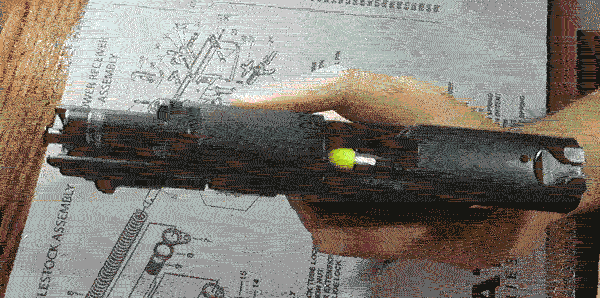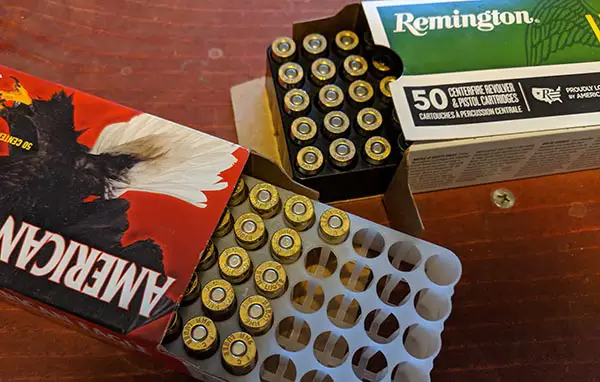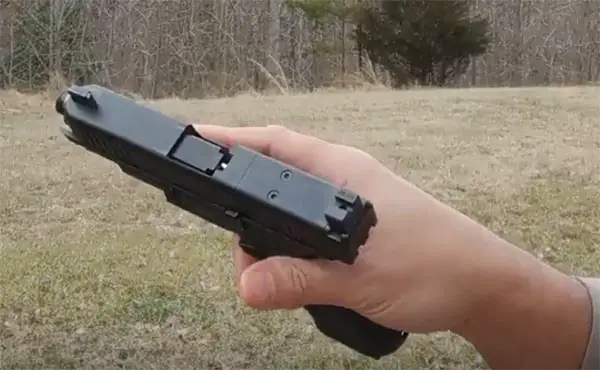Unfortunately, guns don’t work the way we expect 100% of the time. However, nothing is more frustrating than a jammed gun. Some jams are easy to clear while others require a bit more finesse and time. But there are steps you can take to prevent a gun from jamming — especially if you experience repeated stoppages.
To prevent a gun from jamming, it should be kept clean and adequately lubricated. Ensure proper loading and shooting fundamentals to prevent stoppages. Additionally, only fire good quality ammunition that has been properly stored, and is rated for your gun. Finally, check your firearm regularly for worn out or damaged parts and replace as necessary.
Below are some reasons that cause a gun to jam. Hopefully you’ll be able to identify the problem with your gun to prevent future problems.
Table of Contents
What Causes A Gun To Jam
The cause of a jam can be traced back to one or more of the following categories. First, a gun can jam due to improper loading or shooting technique. Another reason your gun might fail to operate is a problem with the ammunition. Finally, issues with the gun itself can also cause a gun to jam.
Each category has a subset of common problems that can result in a jam. Next, I’m going to talk about those common problems and simple solutions that can cut down on the number of stoppages you experience.
Improper Loading Or Shooting Technique
Many gun jams can be traced back to the shooters technique. This cause for a stoppage is not isolated to shooting. Even steps taken in preparation (e.g. loading, putting the gun into battery, etc.) can result in a jam if done incorrectly.
Riding The Slide

Firearms are not fragile machines and are made to operate under extreme pressures. Oftentimes a jam can be the result of a new shooter riding the slide.
So, what do I mean by riding the slide? New shooters will sometimes grip the slide and attempt to place the handgun into battery, instead of allowing the momentum from the recoil spring to pull the slide forward.
Unfortunately, there is a threshold for loading a cartridge into the chamber. Therefore, sometimes a round may get stuck on the feed ramp and the gun will fail to go into battery.
Improperly Seated Magazine
Another cause for jams may be an improperly seated magazine. Similar to riding the slide, a shooter may fail to fully seat a magazine into the gun.
Sometimes new shooters will gingerly insert a magazine into the gun and fail to hear that audible click that accompanies a properly seated mag. Because the cartridge is not properly aligned with the feed ramp the cartridge will get stuck. Consequently, the slide will be stuck halfway and will not go into battery.
Limp Wristing Can Cause Gun Jams
Another common problem that causes a gun to jam is called limp wristing. But what is limp wristing and how does it cause a gun to jam up?
Part of the cycle of operation of a semi-auto handgun is extraction and ejection of a spent casing. When the gun recoils, energy is transferred into the slide which forces it rearward and initiates the extraction and ejection.
However, if the shooters wrist is loose and moves excessively when the gun recoils it can result in a jam. When the casing extracts but fails to eject completely it results in a stoppage commonly known as a stovepipe. Similarly, the spent casing may remain in the chamber, more commonly known as a failure to extract, and can result in a double-feed.
Failure To Clean & Lubricate Your Firearm
Although firearms can take a lot of abuse, they are not impervious to build up. Failure to properly clean and lubricate your firearm can also cause it to jam.
Sometimes, buildup on the feed ramp will cause a cartridge to stick and not load properly. Alternatively, there may be enough friction when not properly lubricated that the guns moving parts will seize up.
A dirty or insufficiently lubricated gun can have all sorts of problems, including frequent stoppages. To prevent a gun from jamming, clean your gun after each usage and lubricate the firearm according to the manufacturers instructions.
Problems With Ammunition Causing A Gun Jam

Although a good number of gun jams can be traced back to the shooter, sometimes the ammunition is the culprit. Usually, this is due to an incompatibility of the ammunition with the gun itself. However, sometimes defective ammunition can also cause a stoppage.
Diva Syndrome – Ammunition Compatibility & Jams
A common belief among the shooting community is that their is inherently good and bad ammunition. Thus, failure to use a quality ammo is more likely to result in stoppages. Although I do believe there is some truth to this, the quality of the ammunition is not always to blame.
Here’s an example from my own history. My first gun was a 1911, and that gun would only shoot ball ammo (FMJ) under certain conditions. Although I attempted to shoot Winchester, Remington, and other “quality” ammunition with the gun it would jam rather consistently. I’ve long since sold that firearm.
Knowing what I know now, it was likely the case overall length that was the issue — not the manufacturers ammunition quality. Sometimes a gun just runs better on a specific brand or type of ammunition.
Defective Ammunition
Another cause for a stoppage could be defective ammunition. Usually, the ammunition will generate insufficient pressure to complete the cycle of operation. However, you can learn more about potential problems caused by defective ammunition, by reading up on misfires, hangfires, and squib loads. There’s even a video where I show how a squib can cause a gun to jam.
Unfortunately, there’s no way to tell if a cartridge will cause you problems until you attempt to fire it. However, proper care and storage of ammunition will cut down on the likelihood that you experience a stoppage due to a defective round.
Gun Jams From Equipment Problems
Assuming you have good ammunition and good shooting technique a gun can still jam. Usually, this is the result of an equipment failure. Below are a few parts on your gun and other reasons that could cause it to consistently jam. To prevent a gun from jamming you should regularly check that all parts are in good working order and swap out
Worn Out Springs

There are a surprising number of springs on a handgun; the recoil spring, the magazine, spring around the firing pin, and more. Although each spring on a firearm serves a different purpose, a worn out spring may cause a gun to jam.
Two important examples of a spring that might cause a jam are the spring located in the magazine, and the recoil spring which controls the movement of the slide.
If the magazine spring is worn out, it may not push the cartridge up high enough to align with the feed ramp for the chamber. Usually this is more evident when you get down to the last few rounds, but problems can present in a full magazine as well.
Alternatively, a worn out recoil spring may result in the slide remaining out of battery despite a successfully fired round. Of course, this can also be attributed to insufficient pressure from the ammunition. Therefore, you’ll need to investigate your specific firearm to find out why you are experiencing stoppages.
Damaged Parts
Another overlooked source of gun jams are damaged parts. Now, you may consider a worn out spring “damaged.” However, the type of damage I’m talking about may, or may not, be attributed to repeated use.
One example that comes to mind is a damaged barrel. If you notice that cartridges stick when attempting to chamber you may have a damaged feed ramp. Perhaps the angle of the ramp is incorrect, or is dented, and therefore won’t feed properly.
Recently, I had to scrap one of my 1911 magazines because it was damaged. Turns out the follower kept wedging cartridges into the top of the magazine body. Although it appeared to function correctly, in practice it did not work.
Break-In Period

Gun jams and fails to go into battery. This issue no longer present after break-in period.
Another reason your gun may jam is because it simply needs some time to break in. Of course, in an ideal world the gun would work straight out of the box. But in reality using your gun wears down friction points and exercises springs.
Another real world example is my Walther PK380. In an effort to make cleaning easier, I bought an aftermarket spring and guide rod assembly. During the first several hundred rounds, it would occasionally fail to go into battery. While it was concerning, the problem ended up working itself out and I no longer experience this kind of stoppage.
Parting Shots
Although avoiding stoppages altogether is near impossible, basic maintenance and proper technique will help prevent a gun from jamming. Routine cleanings and inspection are essential to keep a firearm in working condition. Additionally, if you use quality ammunition you further reduce the risk of a jam.







